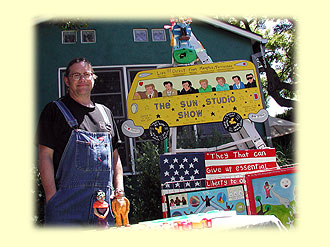 Everyone I know loves Steve White’s art. This probably has something to do with the fact that White seems to approach his subjects—country music, popular culture, society at large—with the fiery zeal of a charismatic, drunken backwoods preacher. But White’s religion, if it can be called that, is much kinder, friendlier and earthbound than your typical fire-and-brimstone Christianity. Even his most vehemently political work, attacking the scourges of violence, injustice and corporate hegemony in our screwed-up, consumer-crazy society, will make a grumpy man smile.
Everyone I know loves Steve White’s art. This probably has something to do with the fact that White seems to approach his subjects—country music, popular culture, society at large—with the fiery zeal of a charismatic, drunken backwoods preacher. But White’s religion, if it can be called that, is much kinder, friendlier and earthbound than your typical fire-and-brimstone Christianity. Even his most vehemently political work, attacking the scourges of violence, injustice and corporate hegemony in our screwed-up, consumer-crazy society, will make a grumpy man smile.
White’s country-themed art is possessed with an even greater joy. I’ve got a birdhouse on my desk on which White painted a dozen stars from the Grand Ole Opry. Depicted in White’s characteristic quasi-naïve painting style, I look at Bob Wills, Stringbean, Johnny Cash, Patsy Cline, Hank Williams, Grandpa Jones and the rest of that great pantheon of country music superstars every day, and god damn if they don’t make me happy to be alive.
White’s art has that kind of effect on people. Folks who otherwise don’t care a fig about art love the miracles White creates. At its root, his art seems tailor-made to bring joy into our sad world.
Like many great folk artists, White came to art late in life at a moment of enormous personal crisis. He made his first painting at the age of 29: a picture of Jesus and the Devil wrestling for lost souls. That painting still hangs on a wall inside his amazing Folk Farm.
“Sometimes I wish I could’ve been satisfied to stay in Ohio and work at the tank plant,” White says. But art became his calling. “Art took away every illusion I have about life.”
If you ever have the opportunity to visit White’s little house of folk, I suggest you do so. Exploring White’s Folk Farm is like exploring the inside of his head. The front yard is strewn with colorful sculptures and cut-outs. The house itself is decorated with all kinds of brightly painted art, an Elvis angel, American flags decorated with surprising slogans.
The inside of the Folk Farm, if anything, is even more amazing. It’s literally a palace of folk. The walls are covered with art by some of the best self-taught artists in the country, folks like RA Miller, Mary Proctor, Myrtice West and White’s mentor, the late, great Howard Finster, who first inspired White to put the visions in his head out into the world. There are also displays of White’s famous PEZ dispensers of country stars, Frida Kahlo, little green aliens, etc. And signed photographs by country stars. And Day of the Dead paraphernalia.
And cats. Lots and lots of cats.
Every year, White holds a folk fest at his Folk Farm so folk artists can sell folk art to folk lovers at folk bottom prices. Next time it comes around, you should come around too.
— Steven Robert Allen
Steven Robert Allen was the Arts and Books editor of Albuquerque’s Weekly Alibi.